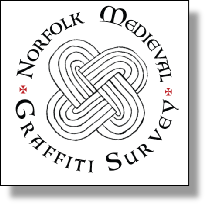Although probably one of the more common inscriptions to come across, on timber, stone, tombs and lead-work, it is also probably one of the most enigmatic. Often shown inverted to resemble a capital ‘M’, or even upon its side, some churches can be found to contain several dozen examples. The symbol has been interpreted as being associated with the cult of the Virgin Mary, and it has been suggested that the ‘V V’ have represented the initial letters of the term ‘Virgo Virginum’ (Virgin of Virgins). However, more recent research suggests this interpretation unlikely.
The possible connection between the 'VV' symbol and the Latin prayer or phrase 'Virgo Virginum' was first mooted by Brian Spencer in 1990, with particular reference to the examples of the motif he was coming across in relation to pilgrim souvenirs. The term 'Virgo Virginum' is the first line of the sung prayer 'O Virgo Virginum', one of the 'O Antiphons' which were chanted at vespers in the days leading up to the feast of the Nativity.In the traditional European catholic church there were seven of these Antiphons, each representing a name and virtue of Christ, with the English church adding the 8th , that of ‘O Virgo Virginum’, in the later Middle Ages.
Even then the phrase wasn’t well known in England, being limited to only the larger religious institutions. The fact that the phrase was largely confined to England also makes the popularity of the symbol in mainland Europe difficult to explain.
It is also one of the few ritual protection marks that made the occasional cross-over into more traditional church art form, appearing above the west door of Fakenham church, in North Norfolk, where it is associate with the Virgin Mary, and on the 15th century font at Aylsham church, where it is associated with the scourging of Christ.
However, the origins of the symbol may be far earlier. The earliest examples of this symbol being used for ritual purposes are to be found in the runic writing systems of Scandinavia, and even today it is still regarded as a Holy sign associated with life, death and fertility in many areas of the eastern Baltic.










